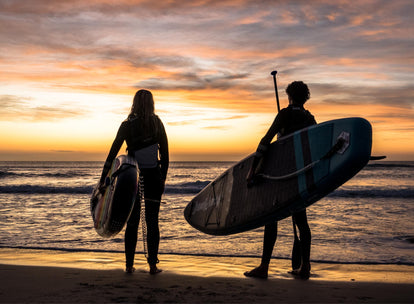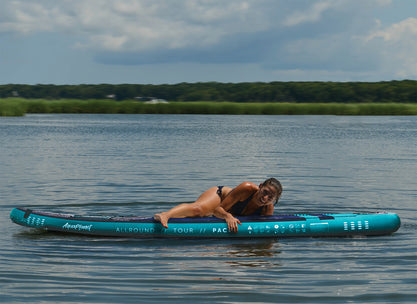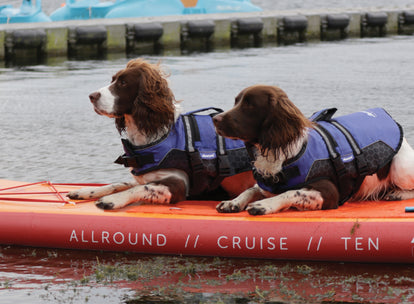Paddle boarding is one of the fastest growing watersports in the UK, and has experienced a rise in popularity in recent years. If you are considering taking up paddle boarding as a new hobby, you might have safety concerns and want to find ways to minimise your risk of injury. Reassuringly, paddle boarding is usually a very low risk sport, especially when safety protocols are followed and you equip yourself with the recommended safety accessories. So what are the recommended steps you can take to help keep yourself safe out on the water?
Get the right equipment

- High quality paddle board
Aquaplanet inflatable paddle boards are very sturdy and are able to cope with high intensity adventures on the water as well as being deflated without getting damaged, but it is worth checking for punctures and damage to your board before you go out onto the water. When inflating your paddle board, remember to inflate it to the correct PSI pressure. In the Aquaplanet instruction manual, you will find the pressure range you should be aiming for when inflating your board to help avoid over or under inflation.
- Dry bag with supplies
Make sure to take a dry bag and pack yourself some fresh water, food for the day, UV protection, and suitable clothing to deal with changes to the weather such as a rain proof layer, warm hat and gloves.
Pump your paddle board to the correct PSI

It’s very important to pump your SUP to the required level to avoid any buoyancy issues on the water. Each inflatable board has a recommended PSI, which you can find on the board itself. Please make sure you keep inflating until the gauge shows the recommended PSI (normally between 15-20 PSI) before using it on the water. This process can take some time, typically it takes 10-15 mins of consistent pumping.
A common mistake is assuming the gauge is broken if it shows 0, the most likely reason for this is that the board isn’t inflated to the minimum level to show (normally needs to be around 5-7 PSI to show).
Means of communication

Keep your phone in a waterproof phone case which will protect it from the elements and allow you to keep it in a convenient place should you need to use it in an emergency You can also make use of not only your phone’s camera to immortalise your SUP experience but also use an app like Strava to record your progress.
Buoyancy aid

No matter your swimming ability, it is always a good idea to wear a buoyancy aid. This will help you stay afloat if you end up in the water should you take a dip, gives you some impact protection and can also provide you with some handy pockets to store essentials. All whilst still allowing you to paddle easily.
- SUP leash

Your paddle board will come with a leash, an important piece of safety kit to keep you attached to your board if you fall off and ensure you don’t get separated from it.
However, choosing the right kind of leash is really important – in surfing conditions or on clear open water then the ankle or calf leashes are ideal, but in any moving water or waterways with overhanging or underwater obstructions then adding a quick release waist or chest belt to your leash is strongly advised. This means you can manually release yourself from the board in the case of any entanglements and safely swim away.
Wear the right clothing

Paddle boarding can be a pretty leisurely sport, but you should still take into consideration what you are wearing. You might see someone enjoying a peaceful evening paddle boarding on the tropical waters of Bali wearing nothing but their skimpy swimsuit on social media, but remember that conditions in British winter are slightly less forgiving! In the winter, you will most certainly want to wear more protective gear - see our SUP clothing guide for what to wear throughout the year
Paddle boarding techniques

The key to paddle boarding safely is to use proper techniques. You may pick it up instinctively by just getting on the water or by watching a few YouTube videos, but many people would find a lesson with a trained instructor very helpful to learn the correct techniques and safety tips. Alternatively, enrol to our free online Paddle Like A Pro course, where we guide you through all the basic techniques and much more.
Take into consideration the conditions

The weather conditions when paddle boarding are one of the most important things you need to think about as it can radically change your experience. Paddle boarding on calm waters such as a lake, is very different to being out on the open ocean. If you are new to paddle boarding, it is best to initially stick to sheltered water with calmer conditions so you can focus on your technique rather than struggling to stay on the board.
Remember to check the weather forecast (and tidal forecast if you are going out on the sea) before you start paddling. Choppy conditions can be rather challenging for a beginner to deal with. Definitely try and avoid offshore winds, as these could blow you off course and out to sea, which could leave you tired and unable to get back to shore. You can often keep track of the wind at a beach by looking out for signs such as the movement of clouds, smoke or trees which will help tell you which way the wind is blowing. Another great tip when out paddling is to keep an eye on two points in your eye line on the shore to see which way any drift is taking you.
Paddle board with a friend (or two)

Whilst paddle boarding alone can be a serene and calming activity, it is definitely advisable for a beginner to paddle in small groups. It can make it more social, but more importantly it means that there is someone to help, or go for help if you do find yourself in difficulty.
Paddle boarding is a fantastic sport that is a lot of fun. To make sure that it stays that way, be sure to follow relevant safety advice before taking your paddle board for a spin.









